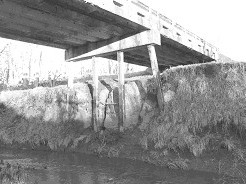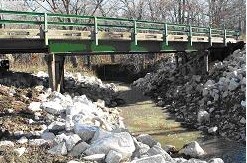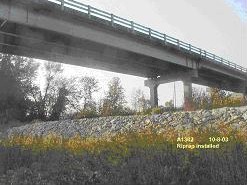611.1 Rock Blanket
611.1.1 Design
Rock blanket should be used to protect roadway slopes, at bridge ends and culverts, and to protect stream banks. On most projects, rock blanket is the economical method of protecting the embankment around grade separation structures and bridge ends. Type 2 rock blanket placed on top of permanent erosion control geotextile shall be used under bridge ends at railroad crossings. The need for rock blanket at bridge ends (refer to EPG 748.7 Bridge Deck and Bridge End Drainage for guidance on extending rock blanket for bridge end drainage concerns) and at bridge box culverts is identified on the bridge field check memorandum. The need for rock blanket at other locations is determined during plan field checks.
Rock blanket at bridge ends of stream crossings extends to at least 30 ft. (9 m) along the roadway embankment from the bridge abutment on the upstream side, and to at least 20 ft. (6 m) along the roadway embankment on the downstream side, unless otherwise specified on the bridge field check memorandum. A typical embankment configuration is shown on Embankment at Bridge Ends. Rock blanket is effective at a thickness from 1.5 to 3.0 ft. (460 to 900 mm), depending on stream velocities and protection needed. The standard specifications define two types of rock blanket. Type 1 rock blanket is specified where the stream velocity is less than 6 ft/s (1.8 m/s). Type 2 rock blanket is specified at bridge ends and at other locations where the stream velocity is 6 ft/s (1.8 m/s) or more. The rock blanket is extended to at least 2 ft. (600 mm) below natural ground or finish grade at bridge ends, and to at least 2 ft. (600 mm) below the stream flow line where used on stream banks, unless otherwise specified on the bridge field check memorandum. If the project contains sources for the rock blanket, excavation of the material is paid for under the appropriate roadway excavation items. Rock blanket material is secured from roadway excavation, if practicable. If not, the contractor is responsible for obtaining the material and the plans include the item for furnishing rock blanket. The plans specify type, location and dimensions for rock blanket and include quantities for its construction. No direct payment will be made for excavating or other work necessary in preparing the subgrade, trenching or backfilling for rock blanket.
For details of rock blanket and concrete slope protection layouts at bridge ends, see the four cases identified on Standard Plan 609.40 and shown on Standard Plan 611.60.
611.1.2 Construction Inspection for Sec 611.30
611.1.2.1 Construction (Sec 611.30.3)
Rock should be placed with enough care to assure that there are no large voids that would allow water to erode the soil below. The 404 permits in the contract should be carefully reviewed before working in a streambed or altering the stream banks.
611.1.2.2 Basis of Payment (Sec 611.30.5)
If the plans show that the material for the rock blanket is to be secured from the project, it is the contractor’s responsibility to shoot it to a usable size, sort it from the Class A material, and if necessary, stockpile it until it is needed. There is no additional compensation beyond the classified excavation payments.
If the plans show material for rock blanket to be secured from the project and this material is made unsuitable or unattainable by the contractor's operations, the contractor has to provide suitable material and dispose of any surplus material at his own expense.
If the plans show that material for rock blanket is to be secured from the project or any other source furnished by the Commission and the required quantity of acceptable material is not actually available, payment will be made under Sec 109 for the purchase and delivery of any additional rock blanket material that is needed.
If the plans do not provide for a source of material, the contractor will supply it and will be compensated under the payment item, “Furnishing Rock Blanket.” If suitable material is encountered on the project and the contractor uses it in the construction of rock blanket, the payment item “Furnishing Rock Blanket” should be underrun and payment made for the appropriate quantity of Class C excavation.
611.1.3 Materials Inspection for Sec 611.30
611.1.3.1 Apparatus
Rule with suitable graduations to accurately measure the material to be inspected.
611.1.3.2 Procedure
Stone or broken concrete shall be visually inspected for quality and size. A sufficient number of individual pieces shall be measured to determine compliance with Sec 611. No Laboratory samples are required.
611.1.3.3 Report (Records)
The stone or broken concrete shall be reported using AASHTOWARE Project (AWP). "Visual Inspection" shall be shown for Acceptance Method. The Remarks or a Free Form test shall indicate the approximate number of pieces measured.
611.1.4 Maintenance Procedures
Rock Blanket prevents or arrests bank and streambed erosion that could affect the stability of the structure. Scour starts at the bottom of the slope and streambed area. If that area is not protected scour will continue to erode the slope. The rock blanket needs to be placed to protect that area if possible. If that is not possible then the bottom of the blanket at the stream level may be made thicker so that as the bank erodes the stones in the blanket will fall into the eroding area and block any further erosion. The extra material at the toe or bottom of the blanket will supply the material that falls into the eroding areas while maintaining an adequate thickness to protect the earth under the blanket.
Scheduling
Rock blanket installation can be done in dry periods with low stream flow. Temperature is not a major consideration unless grading is needed and the earth is frozen. The project should be scheduled when there is adequate material, equipment, and personnel available.
Material
Graded rock for a rock blanket. Standard Specification 611.30 covers the material specifications for a rock blanket. It is a good reference for an adequate gradation for the stone used in the blanket. Note: Normal quarry produced “shot rock” usually has too any small stones and not enough large stones to withstand floodwater pressures.
Procedures
1. Review location for scope of work and size of installation. Prepare an estimate of the material needed for the blanket.
2. Review guidance for Wetlands and Streams. Discuss the location with MoDOT Environmental Section and if a 404 Permit is required then it must be acquired before the work can begin. Review all the Corps regulations before beginning the project.
3. Establish the rock gradation, supplier and method of delivery.
4. Most installations will require the use of a tracked hoe or loader. Equipment will be needed for placement of the rock.
5. Prepare the site for the rock blanket as governed by the Corps of Engineers work regulations. If possible key the rock into a trench below the streambed elevation.
Safety Concerns
Location of all utilities.



